nano@illinois RET Teachers Discover Nanotechnology's Big Impact—Hope Their Students Will Too
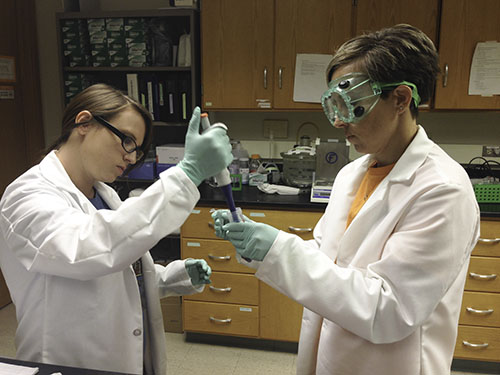
nano@illinois RET teachers Kala Oglesby (left) and Beth Koplinski at work in an Illinois lab (photo courtesy of Kala Oglesby).
August 31, 2016
This summer 11 teachers of varying grade levels and backgrounds participated in the nano@illinois Research Experience for Teachers (RET) funded by the National Science Foundation. While participating in research in a wide range of areas, these teachers’ eyes were opened to the intricate world of nanotechnology and all the possibilities it offers. But while the research is important, that’s not the program's only goal. It is expected that these teachers will then take all that they learned through their research on nanotechnology and, with support from staff and other teachers, translate it into lesson modules they can use with their students back home. It is hoped that as they are able to successfully teach their students what they’ve learned, they’ll not only be exposing them to STEM, but some of its cutting-edge possibilities, like nanotechnology, that their students may never been exposed to before because of a variety of factors, including their socioeconomic background.
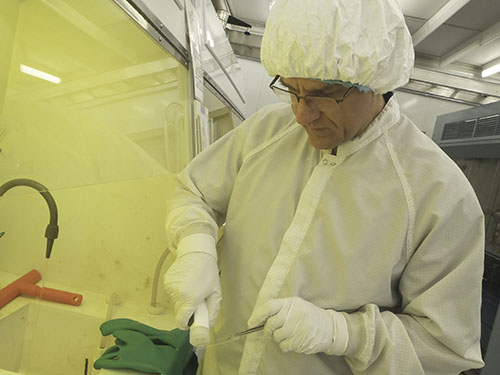
nano@illinois RET teacher John Roach conducts research in the cleanroom (photo courtesy of John Roach).
During the research experience, which was held from June 13–July 22, 2016, the teachers were able to conduct research in a wide range of research areas, depending on what their interests were, including nanomaterials, systems integration, nano electronics and nano photonics, bio nanotechnology and nano medicine, physics, and chemistry. Then, the second part of the experience, was to take what they had learned and create instructional materials. One challenge these teachers encountered was this: their research had been done in a cutting-edge lab using expensive nano machinery; they had to find a way to replicate something similar to that in an inexpensive way in the classroom.
And while the short-term goal of the RET was to expose these teachers to research, the hoped-for long-term impact was to expose students, especially underserved populations, to nanotechnology research, specifically, and to STEM in general.
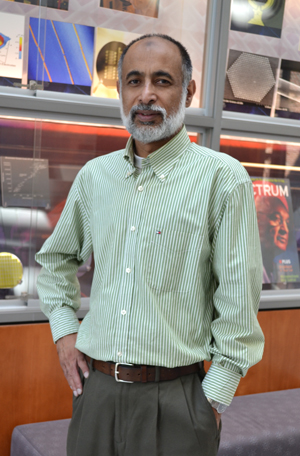
Irfan Ahmad, Executive Director, Center for Nanoscale Science and Technology, and nano@illinois RET Program Manager.
According to Irfan Ahmed, the executive director for the Center of Nanoscale and Science Technology (CNST), “the goal of this program is to have a diverse group of participants” meaning having teachers, including women, “coming from Hispanic teaching schools or schools with large populations of underrepresented minorities.” Ahmed states that this “is the biggest gain, so we can stir up this knowledge base and get these kids interested in science and engineering.” In the past, the people who make up most STEM fields have been typically homogenous. So one of the goals of nano@illinois RET is to help make STEM a much more heterogeneous field.
Lynford Goddard elaborates on how many students could potentially benefit from their teachers participating in this program.
“For each teacher that we train, they will be interacting with—if they have the same students all day— then it’s 30 students. If they have different periods, then they’ll be interacting with 200 or so students throughout the day.” Goddard explains how this wide exposure is another goal of the program.
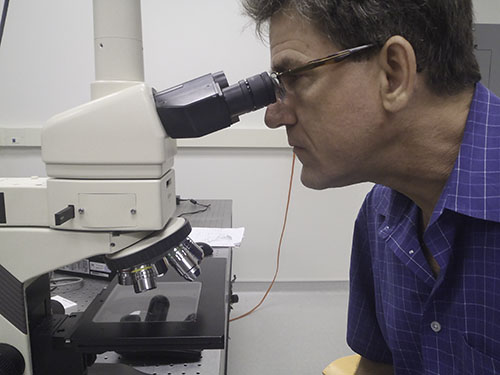
RET teacher John Roach uses a microscope in his MNTL lab (photo courtesy of John Roach).
“Being able to get a little bit of the experience they have here and translating that and sharing their experience with their students is sort of the big goal of the program. [The goal] is to amplify the impact we can have as a university by training the teachers who can then teach the students.”
Using Goddard’s estimations and a conservative approach to estimate how many kids might be impacted by this program, we would expect a minimum of 330 students to benefit and that’s just for one year. This number is an underestimate, since many of the RET teachers interact with many more than 30 students a day. But exposing this many students to nanotechnology and STEM greatly increases the chances that some of these kids will end up in a STEM field and could possibly aid in the creation of the next great scientist.
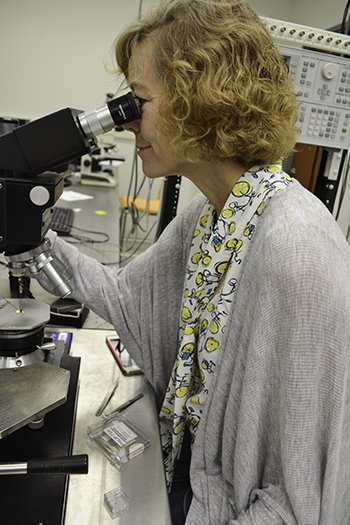
Kelly Jolley at work in an MNTL lab.
Kelly Jolley
It is also hoped that the program’s impact will be amplified even more if the teachers taking part in it share with the other teachers at their school, who then share with all of their students. Kelly Jolly, who returned to nano@illinois for a second year, did exactly that. She describes her experience:
“What we do is, the module that I did for last year, it has a PowerPoint introductory, it has a worksheet for the students, and it has a teacher guide that aligns everything. It gives you background information. It goes through the background, the research is all checked.” Also very important—it is aligned with the state’s Next Generation Science Standards.
“Because if it doesn’t match up with the Next Generation Standards, teachers don’t have enough time to go dabble in what’s new and upcoming… So it’s really nice to be able to see those standards. So that’s already done for the teacher.”
While Jolley may be the only teacher from her district to attend nano@illinois, she’s been able to make her research versatile, informative, and is very well organized. Thus, it saves other teachers time and allows them to present material to their students that they might not have otherwise had time for . “It’s really nice because you can take what you have learned here and fit it in with your curriculum,” Jolley explains. “So when you’re finished here, what you do is very usable for yourself and other teachers who will be teaching the same material.”
Jolley says nano@illinois has helped her stay in the know: “I’m more well versed in what’s going on in technology and what some of the changes are and what [the students] can look for in the future,” she says, “Which is really important.”
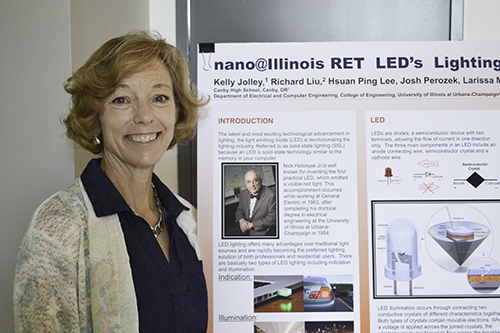
Kelly Jolley presents a poster about her resarch on LEDs.
Jolley says being up to date on new scientific trends is beneficial for students not only because they’ll be learning new things, but because this early exposure could result in their choosing a STEM field (nanotechnology, perhaps?) as a career.
“Because as you look at these technologies, you can tell them about emerging careers. That’s why they’re in the classroom: to figure out how to build their life and find out what they want to study. If there isn’t someone there to pass on the word on what material science is, what nanotechnology is, then they don’t know to even consider that for a job field. With these modules, we can really get them hooked.”
Kayla Oglesby
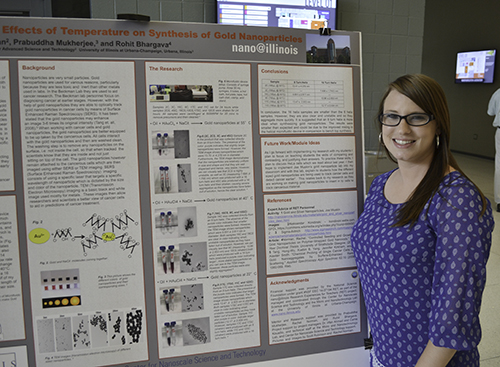
Kayla Oglesby presents a poster about her resarch on LEDs.
Teacher Kayla Oglesby also believes her participation in Nano@illinois has enriched her students’ experience:
“The program benefits my students because I am able to bring back new content, information, and techniques my students have never seen before. I plan to implement 3D printing and the synthesis of gold nanoparticles in my classroom in hopes of getting students more excited about science. Being that I come from a rural, poverty-stricken area, most of my students have never participated in scientific labs, and so I hope to bring this back and show them a different view of science.”
Oglesby’s students aren’t the only ones to benefit from this program, it was also a learning experience for Oglesby herself. She reflected “I believe the experience alone has taught me how to be a student again. It reminded me of the struggles our students often face when learning new information, and so now, I have a better understanding of how my students often feel.”
Tatiana Stine

Tatiana Stine presenting her research on graphene.
Another teacher who believes her students will benefit from her nano@illinois experience is Tatiana Stine, who’s been teaching for 22 years and works with all grades. Stine is also working on Next Generation Science Standards for teachers, which is why she’s interested in this program.
“One of the goals of the Next Generation Science Standards is more engineering in the classroom,” she explains. “So if they were given more ideas to integrate engineering into a classroom, then it would be done more often in an elementary classroom.”
Stine goes on to explain how through her work at nano@illinois, she hopes to simplify the process:
“So I’ve taken each step of my research process and made an elementary application for it. From synthesizing graphene to measuring data with a scaled version, with activities to represent every step. It’s taking a lot of these things and putting it into a 5–10-year-old’s level. I think that’s what I’m going to take back with me. The ideas—how you can do little tweaks and take the world of nano into an elementary classroom. Obviously you can’t do the actual size, but you can scale it up and represent the same activities. If you get them hooked early, the kids will think graphene is so cool, and that spark could make them the next big nano scientist.”
(For more about Stine's RET experience, see: http://www.istem.illinois.edu/news/nanoRET16.stine.html)
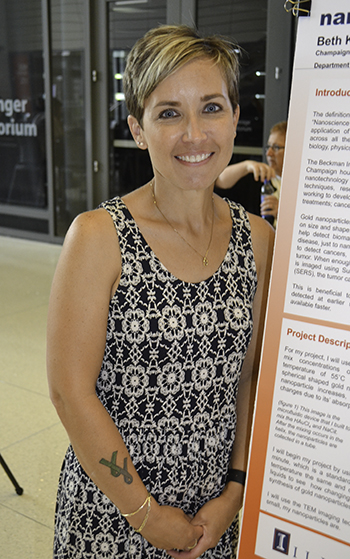
Elementary school teacher Beth Koplinkski presenting her research at the nano@illinois final poster session.
Beth Koplinkski
Beth Koplinkski, an elementary school teacher, is also hoping to get her students hooked on science. When asked what she’s learned and taking back with her Koplinkski answers “I want to teach my kids about different kinds of mixing. The microfluidic device we had, we actually did a lot of mixing inside the helix of chemicals, and so I want to take that back, and I want to teach my kids a little bit about different types of mixing, different types of flow, that kind of thing.
Koplinski hopes to do more than teach her students about types of mixing. “I also want to talk to them about science careers. I mean, get them excited and elementary school kids about science, do some hands- on things with them, and maybe have some people from the university come over and be good role models for them.”
Koplinkski’s students aren’t the only ones getting a learning experience. Reflecting on her summer experience she explained, “Personally I learned how to measure in the lab because being an elementary major we don’t have the technical hands-on science in our programs like a lot of high school teachers who teach science have. So I learned to measure; I learned about different chemicals and how they react with other chemicals; I learned what microfluidics is.”
Koplinkski wasn’t the only RET teacher to personally gain a lot through this program. Diana Rodriguez, a teacher for 13 years, described this experience as “Amazing! I learned a lot of things about research and techniques. I learned to experiment and how to keep a lab notebook, participate in lab group meetings.” These personal interactions were extremely important for Rodriquez because she’s not confident in her English speaking ability. She explains “I decided to come here because I have a problem with my English language, and I wanted to get out of my comfort zone and push me to speak English.”
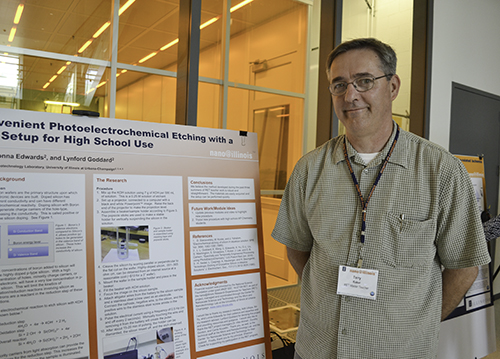
nano@illinois RET Master Teacher Terry Koker presents his research at the final poster session.
While nano@illinos RET is a great program for educating teachers on nanotechnology and new scientific knowledge, it’s important to note that the teachers do have actual cutting-edge research projects they work on while they’re in the program. For example, Terry Koker continued the research he began back in 2014 and was actually patented in 2014. He boasts “My name is on the patent, it’s the coolest thing to be able to put it on the wall as a high school teacher and show your students that you are patented.”
The nano@illinois RET is led and administrated by:
- PI Xiuling Li, Electrical and Computer Engineering
- Co-PI Lynford Goddard, Electrical and Computer Engineering
- Irfan Ahmad, Executive Director, Center for Nanoscale Science and Technology, and nano@illinois RET Program Manager
- Carrie Kouadio, Program Coordinator, Center for Nanoscale Science and Technology, and nano@illinois RET Program Coordinator
nano@illinois RET is managed by the University of Illinois Center for Nanoscale Science and Technology at the Micro and Nanotechnology Lab.
Story by Alexandra Anne Peltier, I-STEM undergraduate student, and Elizabeth Innes, Communications Specialist, I-STEM Education Initiative. Photographs by Elizabeth Innes (unless otherwise noted).
More: MNTL, Nano@illinois, RET, Summer Research, Teacher Professional Development, 2016
For additional istem articles on the Nano@illinois RET, please see:
- nano@illinois RET Participant Tatiana Stine Hopes to Help Expose Youngsters to Nanotechnology
- RET Teachers Experience Multidisciplinary Nanotechnology Research via nano@illinois
- 2015 nano@illinois RET Teachers Perform Nanotechnology Research, Make Modules
- Local Science Teachers Experience Research in NanoTechnology
- Local Biology Teacher to Introduce her Students to Research on Quantum Dots
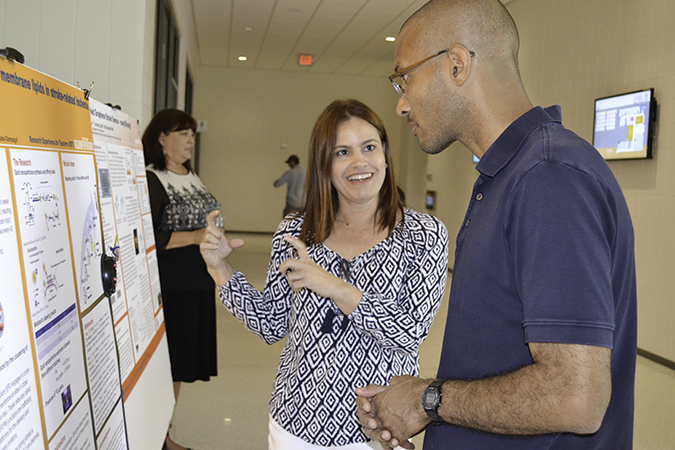
Diana Rodriguez explains her research to nano@illinois co-PI, Lynford Goddard.













.jpg)
















